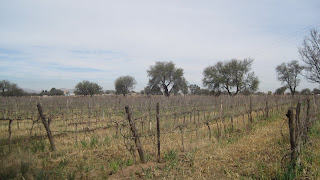And then there's just the relaxed educational environment. Homework is basically non-existent. A study abroad director from Occidental College came to visit our program and commented that non-US students always complain that US classes are filled with busy work; US students abroad complain that there is very little schoolwork throughout the semester and then huge final projects that constitute the entire course grade. My experience has been somewhat like the latter.
It's reasonable to say that I have been stuck in a rut for a while and I've tried to analyze why. In the first month everything is new and overwhelming. The second month you start to find your stride, but you realize you're spending too much money and you need to cut back to make it last for four more months. In the third month, even though you haven't turned in that many papers, you're still ready for a break and you have two glorious weeks to travel, sleep or whatever. Then all of a sudden it's April and you realize that you only have one month left and big projects are looming over your head. Two exchange students in my program are studying for their second consecutive semesters, and while Guanajuato could start to be a bit boring for 10+ months*, I can see the benefits of staying on for two semesters. (No I am not planning on staying on; I am graduating, so I don't think it's actually possible, and I have many commitments awaiting me in Rhode Island.) But the acclimation process can take so long that once you've settled in and figured out what the Mexican university system wants from you, it's time to go! Also two semesters would give you the option to take more classes alongside Mexican students, which really is the best part of the program.
So with this precious free-time I've done some traveling and had a few visitors. Mid-March I went with a few students from the program to Zihuatanejo and Ixtapa in the state of Guerrero. A relatively comfortable bus ride on 1st class Primera Plus brings you to the beach in under 7 hours for about $80 round trip. One of the girls is very familiar with this area because her family has a time-share in the area so we enjoyed the benefits of beach-connections! Cheap taxi rides, free lodging, and the insiders scoop on where to eat and beach. We even got free surfing lessons. Thanks Jourie!
The first 5 days of Semana Santa I spent in Mexico City with my partner, Paul. I could return to that city (megalopolis) over and over again. Plenty of people will tell you that it's too dangerous to visit, and I do know people who have been assaulted repeatedly, but we, fortunately, had a fantastic hassle-free time. We kept the trip low-stress and visited one or two sites a day, walking and taking the subway everywhere. Public transportation systems are always a must-see for me in any city and the metro in DF is maybe my all-time favorite. For 3 pesos you can transverse miles and miles (I mean kilometers) of city - transfers included - in a super clean car. There are even designated cars for women and children to avoid the crush of the crowd or any harassment. Vendor after vendor jump through the cars selling all sorts of bootleg mix CDs, promoting their wares through a boombox/back pack combination that belts out selected songs. I'm still kicking myself for not buying the 10 peso Mexican surf-rock CD.
Some other highlights from this trip: yummy food on a trajinera floating in Xochimilco (minus the annoying tour group), walking through La Condessa and finding a giant dog park and a group of elderly people taking salsa lessons, the brand new contemporary art museum (MUAC) at the Universidad Nacional Autonoma de México (UNAM), viewing the gorgeous murals that adorn the library at the UNAM, and delicious guacamole and chelas every night at the super-chido hostel right in the Zocalo. Can't wait to go back!
The second part of vacation was spent with m great US beach-bud in Puerto Vallarta. Many people warned us that the beach would be too crazy because it's one of the most popular destinations during vacation week. But we braved it anyway and had an awesome time even before the crowds cleared out on Easter Sunday. We stayed at a beautiful hostel just 2 blocks from the beach and ate delicious food every day. I highly recommend Planeta Vegetariano and El Brujo to anyone that travels to Vallarta. The tacos are a little bit more expensive there (everything is in a tourist town) but the extra few pesos are well worth it. Fish, shrimp and octopus tacos. Whole red snappers. Ahhhh coastal living. Also I successfully avoided a sunburn and reaffirmed that I do not like coconut water.
Ten days later I enjoyed a much-needed visit from my parents. I took them around to some of the classic GTO sights, including the mine in Valenciana, the churches, and art museums. We also spent a fair amount of time relaxing at their great B&B, Casa Zuñíga, watching Mark Bittman videos and eating mangos. You know, how the Zucks roll.
* Guanajuato is beautiful, the people are friendly and I'm glad I chose this as my study-abroad destination. However, its relative small size (while good for safety and meeting people) can make for some very boring evenings. Also, the city is quite conservative and sometimes I feel trapped inside a protective bubble. When traveling in Vallarta, I was refreshed to see gay couples holding hands in public. "Oh right!" I said to myself. "There are places in Mexico where people have the freedom to be themselves."























